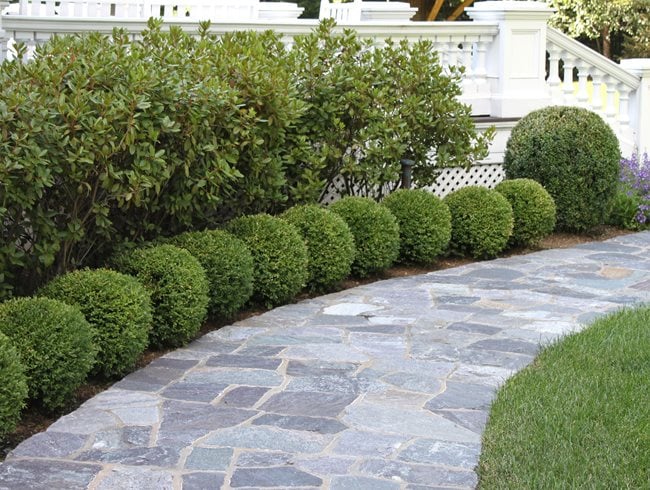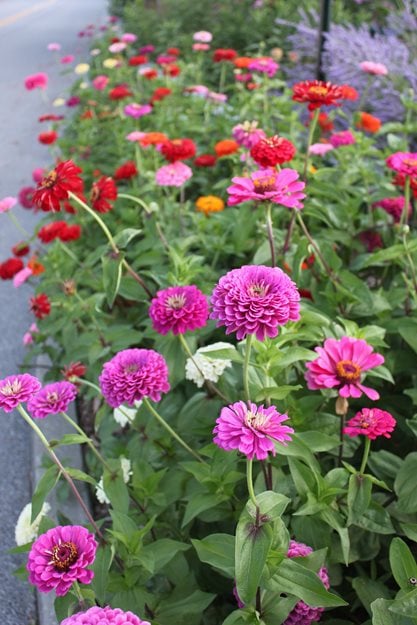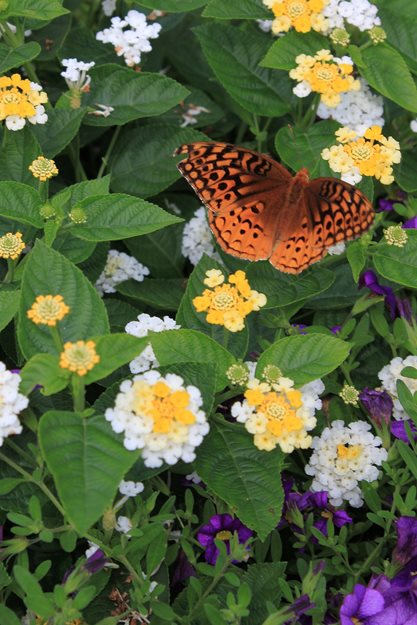Planting Ideas for Your Garden
Tips for selecting plants with purpose that have captivating foliage, flowers and fragrance and attract bees, birds and butterfliesPlanting design, often overlooked, can be tricky for new and experienced gardeners alike. Use the following suggestions to ensure that the plantings in your garden have a clear purpose and grab the attention of people, bees, birds and butterflies.
SELECTING PLANTS WITH PURPOSE
1. Choose Plants Wisely for the Front Row
The plants at the visible edge along a walk, patio, or lawn, can make all the difference in its appearance. Low-growing plants in the front row accentuate the shape of the bed, soften harsh edges, and help draw attention to the taller plants behind.

Low-growing boxwood, shaped as small globes, make a neat and intriguing edge along a stone walk. Photo by: Jan Johnsen.
Low-growing plants in the front row should be full, look good in a line, and not require too much care. If you view a garden bed from a distance, the height of edging plants can be relatively high—around 2 feet. In beds that are viewed up close, the border plants should be lower than 2 feet.
Annuals such as sweet alyssum make a wonderful white edging with its dense, tiny, fragrant white flowers. If cut back they will bloom all season. The perennial green and white variegated lilyturf (Liriope muscari) is another of my favorites for edging beds.
2. Think About Sunlight’s Impact on Color
Our color choices in the landscape are, for the most part, influenced by our geographic locale, the sun’s intensity, and the time of year. For example, in England, pastel colors captivate while bright colors may appear garish in the muted, north light. This is why Gertrude Jekyll, the famed British garden designer, saw purple as a difficult color. But in a bright, sunny subtropical garden, every shade of purple and magenta is exuberantly appealing.

The orange and purple found in the ‘Magnus’ coneflower (Echinacea purpurea ‘Magnus’) looks great in the intense summer sun. Photo by: Jan Johnsen.
Similarly, our color preferences can change with the season. In early spring, when the light is soft, we are thrilled by light pink and soft yellow. As the year progresses, and the sun becomes stronger, pastels look washed out and we crave stronger reds, golds and oranges outdoors.
3. Consider Form, Line & Color
It is not often that plants are referred to as an arabesque, which means a sinuous decorative line or motif. But it makes sense that a master landscape artist from Brazil, Roberto Burle Marx, saw plants in this way:
“A garden is a complex of aesthetic and plastic intentions; and the plant is, to a landscape artist, not only a plant — rare, unusual, ordinary or doomed to disappearance — but it is also a color, a shape, a volume or an arabesque in itself.”
- Roberto Burle Marx
He counsels us to view plants as part of a design palette, appreciating their form, line or color and to envision what they might add to a garden.

The yellow-and-green-striped, bold foliage of ‘Bengal Tiger’ canna lilies always steal the show. They contrast nicely with the white flowers of the peegee hydrangea in the summer. Photo by: Jan Johnsen.
CAPTIVATING WITH FOLIAGE, FLOWERS AND FRAGRANCE
4. Create a Foliage Tapestry
I find it interesting that, while we may plant a large mass of one low-growing plant as a groundcover, Nature, if given a choice, prefers to mix it up, with many species growing side-by-side. Why not do the same and plant a conglomeration of different foliage and groundcover plants that like the same conditions?

This stunning symphony of groundcovers and ferns is in Phyllis Warden’s garden in Bedford, NY. Red-leaved Perilla contrasts with white and green ‘Jack Frost’ brunnera (Brunnera macrophylla 'Jack Frost'), Japanese painted fern (Athyrium niponicum pictum) and the lime colored bleeding heart (Dicentra spectabilis ‘Gold Heart’). Photo by: Jan Johnsen.
Some advise against this style of planting because intermixed plants may be hard to care for. But if you do not want a monolithic look, and don’t mind some tending, plant a combination of small-leaved groundcovers with large-leaved foliage plants. The result can be downright captivating!

Join us for our next webinar!
From Plan to Planting: Designing a Garden for Every Season, with Rebecca Sweet
May 15, 2025
5. Embrace the "Sound" of Flowers
The temple bell stops but I still hear the sound coming out of the flowers.
- Basho (Japanese poet, 17th century)

Multi-colored zinnias "sing" in unison on a summer morning. Photo by: Jan Johnsen.
No matter how beautiful an outdoor space is, it is always the pot or plant bed full of flowers that garners the most praise. The delight that flowers bring goes beyond pretty blossoms and sweet-smelling fragrance. Using the metaphor of music, flowers add high-pitched, sweet tones to the symphony within a garden. It is their soaring song, with notes of blue, pink, white and more that we all savor.
6. Incorporate Food for the Nose
Aroma is food for the nose. On average, a person draws 23,000 breaths a day and the scents contained in each breath convey information, mood and provoke memories in a way that nothing else can. Here are three tips for incorporating scented plants in a landscape:
- Place fragrant plants close to your house so you can catch a whiff of the aroma as you enter your home.
- Place scented plants on a sunny patio or near a south-facing wall. The reflected heat may make the odors a little stronger.
- Plant fragrant plants in an enclosed space, such as a walled garden or small side yard. The scent will collect instead of being carried away by the breeze, so you'll be surrounded with aroma.
Get suggestions for fragrant flowering shrubs and learn how to create a peaceful garden.

Nothing can alter our mood as quickly as scent. This is because smell goes directly to the limbic section of the brain that controls stress levels, heart rate and blood pressure. Roses are both beautiful and therapeutic! Photo by: Jan Johnsen.
ATTRACTING BEES, BIRDS AND BUTTERFLIES
7. Remember the Pollinators
A garden is a complex, natural world that we often overlook. While we are admiring the color, fragrance and look of a glorious landscape, hummingbirds, butterflies, bees, birds and more are tirelessly pollinating our plants. Global evidence suggests that pollinator populations are declining due to many factors, including habitat destruction, so please consider making your garden a haven for these amazing creatures.

Bees and butterflies love clustered mountain mint (Pycnanthemum muticum). It has pinkish-white, aromatic flowers surrounded by silver bracts. Blooms August through September. Photo by: Jan Johnsen.
You can start attracting pollinators to your garden by planting flowers, trees and shrubs that are nectar-rich. Also, consider the colors they like. For example, hummingbirds are particularly fond of red, while bees seem to prefer flowers in the purple/violet range.
For more, see: Flowers for a Bee-Friendly Garden.
8. Birdscape with Berried Plants
Many plants produce fruit or seed in late summer to fall when birds are getting ready to migrate south. The fruit of plants such as dogwood (Cornus), crabapple (Malus), and elderberry (Sambucus) add interest to the landscape while nourishing our feathered friends. And you might consider planting one of the many Viburnum varieties. Viburnum berries attract a host of birds in the fall such as robins, bluebirds, thrushes, catbirds, cardinals, finches and waxwings. Discover more berry-bearing trees and shrubs.

Crabapples are small-statured ornamental trees known for their fruit. The varieties that have persistent small crabapples, less than three-fourths inch in diameter, can feed birds into the winter. Some bird-friendly cultivars to consider include ‘Sargent’, ’Red Splendor’, and ‘Donald Wyman’. Photo by: Jan Johnsen.
Chokeberry (Aronia spp.) is a native berried plant that holds on to its fruit over the winter. This wetland shrub, true to its name, has fruits that are quite bitter. Because of this, birds don’t eat them until they’ve undergone several freeze/thaw cycles. Thus, the berries provide both winter food as well as color. A chokeberry to try is the hardy, self-fertile ‘Viking’ black chokeberry (Aronia melanocarpa 'Viking'). Its extra-large black berries persist through the winter, feeding the first returning robins.
9. Bring on the Butterflies
“Happiness is a butterfly, which when pursued, is always just beyond your grasp, but which, if you will sit down quietly, may alight upon you.”
- Nathaniel Hawthorne

‘Lucky White' lantana and ‘Superbells Blue’ calibrachoa are a great combo to attract butterflies. Photo by: Jan Johnsen.
The brief joy of a butterfly encounter is well worth the effort to plant a garden dedicated to attracting these lovely pollinators. Summer-blooming flowers such as lantana, ageratum, cosmos and dahlias are great butterfly magnets.
Perennial flowers that are full of nectar are a butterfly's delight. Good options include coneflowers, hyssop, bee balm, catmint, and asters among others (get suggestions for butterfly garden plants). So if you have a sunny open spot, some shelter from wind, and fresh water (they like shallow puddles), then plant some butterfly flowers and sit down quietly to enjoy a bit of happiness.
For more, see: How to Make a Butterfly Garden.



